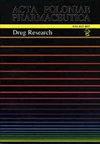在饮食对疾病病程影响的背景下,分析因COVID-19而居家隔离的女性饮食行为
IF 0.4
4区 医学
Q4 PHARMACOLOGY & PHARMACY
引用次数: 0
摘要
这项研究的目的是收集和分析由于严重急性呼吸系统综合征冠状病毒2型感染而在家隔离期间人们的饮食行为和身体活动数据。此外,这项研究的目的是展示味觉和嗅觉障碍如何影响饮食行为。识别饮食错误,然后向该范围内的患者提出建议,可以帮助避免严重的新冠肺炎感染并加快康复。进行了一项匿名在线调查,以研究2022年4月至8月期间新冠肺炎患者的饮食行为和体育活动水平。该研究工具包括一份专门设计和结构化的问卷和FFQ-D10食物频率问卷。共有159人完成了问卷调查。在这一数字中,有153名18岁以上的女性因新冠肺炎而被纳入研究。结果显示,每天摄入1.133份谷物产品,其中未精制的燕麦和全麦或带籽的“棕色”面包更为常见。蔬菜消费量为每天2.225份,新鲜水果为每天1.774份。糖果的摄入量为每天0.511份。研究参与者最不可能消费的产品是加糖饮料、红肉、传统的加糖甜水果蜜饯、干果和加糖乳制品饮料。通过对参与研究的女性的人体测量特征和饮食行为进行分析,可以为新冠肺炎患者制定饮食建议。本文章由计算机程序翻译,如有差异,请以英文原文为准。
Analysis of women's eating behaviours in home isolation due to COVID-19 in the context of the dietary impact on the course of the disease
The aim of the study was to collect and analyse data on people's eating behaviours and physical activity in home isolation due to a SARS-CoV-2 infection. In addition, the purpose of the study was to show how taste and smell disturbance can affect eating behaviours. Identifying dietary mistakes and then making recommendations to patients within that scope could help avoid a severe COVID-19 infection and speed up recovery. An anonymous online survey was conducted to study the dietary behavior and physical activity levels of COVID-19 sufferers between April and August 2022. The research tool comprised a specially devised and structured questionnaire and the FFQ-D10 food frequency questionnaire. A total of 159 people completed the questionnaire. Out of that number, 153 women over 18 years of age who were in home isolation due to COVID-19 were included in the study. The results show that 1.133 portions of cereal products were consumed daily, with unrefined groats and wholemeal or 'brown' bread with seeds being more common. Vegetable consumption stood at 2.225 portions per day, and fresh fruit at 1.774 portions per day. For sweets, consumption was 0.511 portions per day. Products that the study participants were least likely to consume were sweetened drinks, red meat, conventionally sweetened sweet fruit preserves, dried fruit and sweetened dairy drinks. Analysis of the anthropometric characteristics and dietary behaviour of women who participated in the study allowed for the preparation of dietary recommendations for COVID-19 patients.
求助全文
通过发布文献求助,成功后即可免费获取论文全文。
去求助
来源期刊
CiteScore
0.80
自引率
0.00%
发文量
74
审稿时长
6-12 weeks
期刊介绍:
The international journal of the Polish Pharmaceutical Society is published in 6 issues a year. The journal offers Open Access publication of original research papers, short communications and reviews written in English, in all areas of pharmaceutical sciences. The following areas of pharmaceutical sciences are covered: Analysis, Biopharmacy, Drug Biochemistry, Drug Synthesis, Natural Drugs, Pharmaceutical Technology, Pharmacology and General.
A bimonthly appearing in English since 1994, which continues “Acta Poloniae Pharmaceutica”, whose first issue appeared in December 1937. The war halted the activity of the journal’s creators. Issuance of “Acta Poloniae Pharmaceutica” was resumed in 1947. From 1947 the journal appeared irregularly, initially as a quarterly, then a bimonthly. In the years 1963 – 1973 alongside the Polish version appeared the English edition of the journal. Starting from 1974 only works in English are published in the journal. Since 1995 the journal has been appearing very regularly in two-month intervals (six books a year). The journal publishes original works from all fields of pharmacy, summaries of postdoctoral dissertations and laboratory notes.

 求助内容:
求助内容: 应助结果提醒方式:
应助结果提醒方式:


